low oil pressure CHEVROLET CAVALIER 1994 1.G Owners Manual
[x] Cancel search | Manufacturer: CHEVROLET, Model Year: 1994, Model line: CAVALIER, Model: CHEVROLET CAVALIER 1994 1.GPages: 243, PDF Size: 15.06 MB
Page 90 of 243
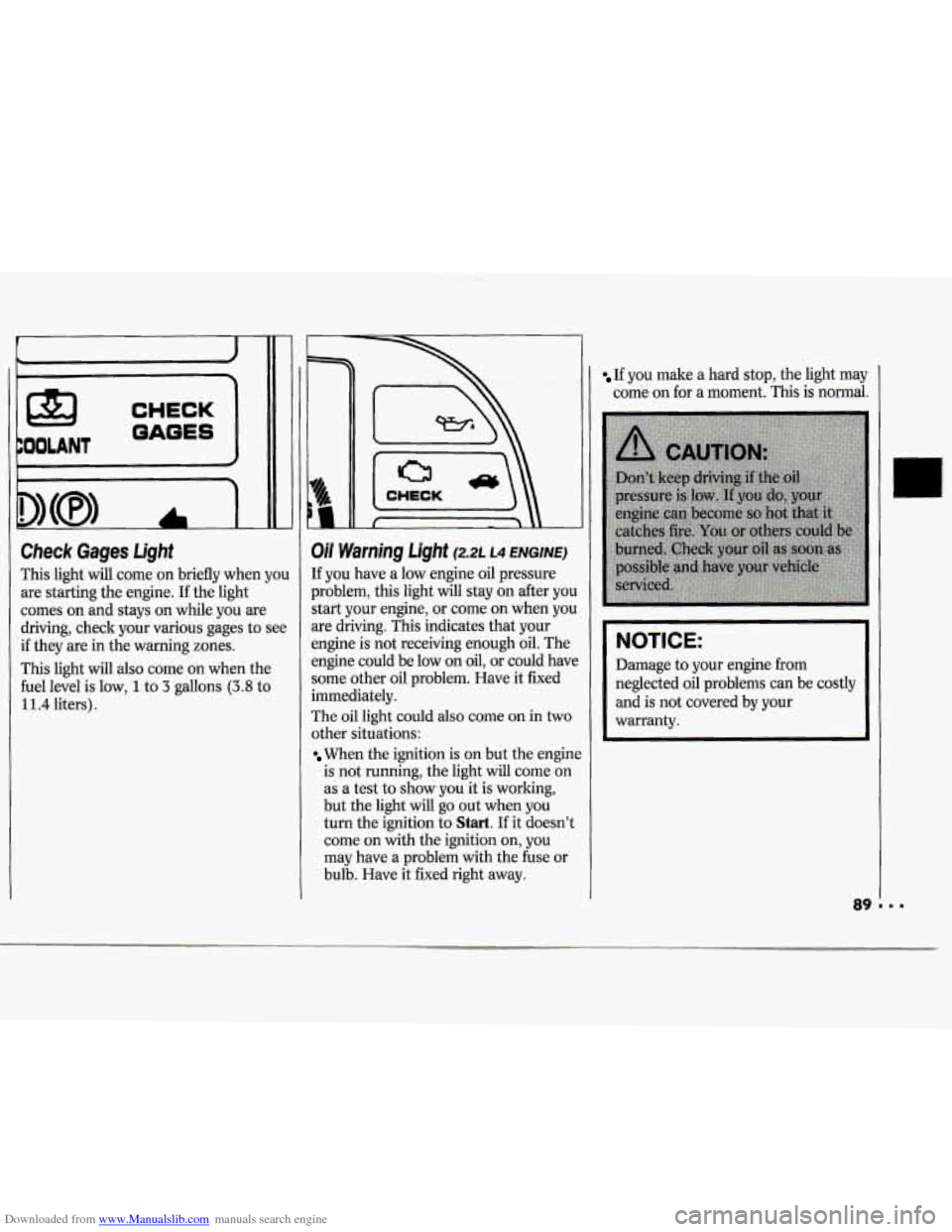
Downloaded from www.Manualslib.com manuals search engine r
c
CHECK ’
OAGES
NOLANT J
D)(8,
I
Check Gages Light
This light will come on briefly when yo1
are starting the engine. If the light
comes on and stays on while you are
driving, check your various gages to see
if they are in the warning zones.
This light will also come on when the
fuel level is low,
1 to 3 gallons (3.8 to
liters)
Oil Warning Light (2.2~ ~4 ENGINE)
If you have a low engine oil pressure
Iroblem, this light will stay on after yob
start your engine, or come on when you
ue driving. This indicates that your
mgine is not receiving enough oil. The
mgine could be low on
oil, or could haw
some other oil problem. Have it fixed
immediately.
The oil light could
also come on in two
other situations:
When the ignition is on but the engin
is not running, the light will come on
as a test to show you it is working,
but the light will go out when you
turn the ignition to
Start. If it doesn’l
come on with the ignition on, you
may have a problem with the fuse or
bulb. Have it fixed right away.
If you make a hard stop, the light may
come on for a moment.
This is normal.
NOTICE:
Damage to your engine from
neglected oil problems can be costly and is not covered by your
warranty.
Page 91 of 243
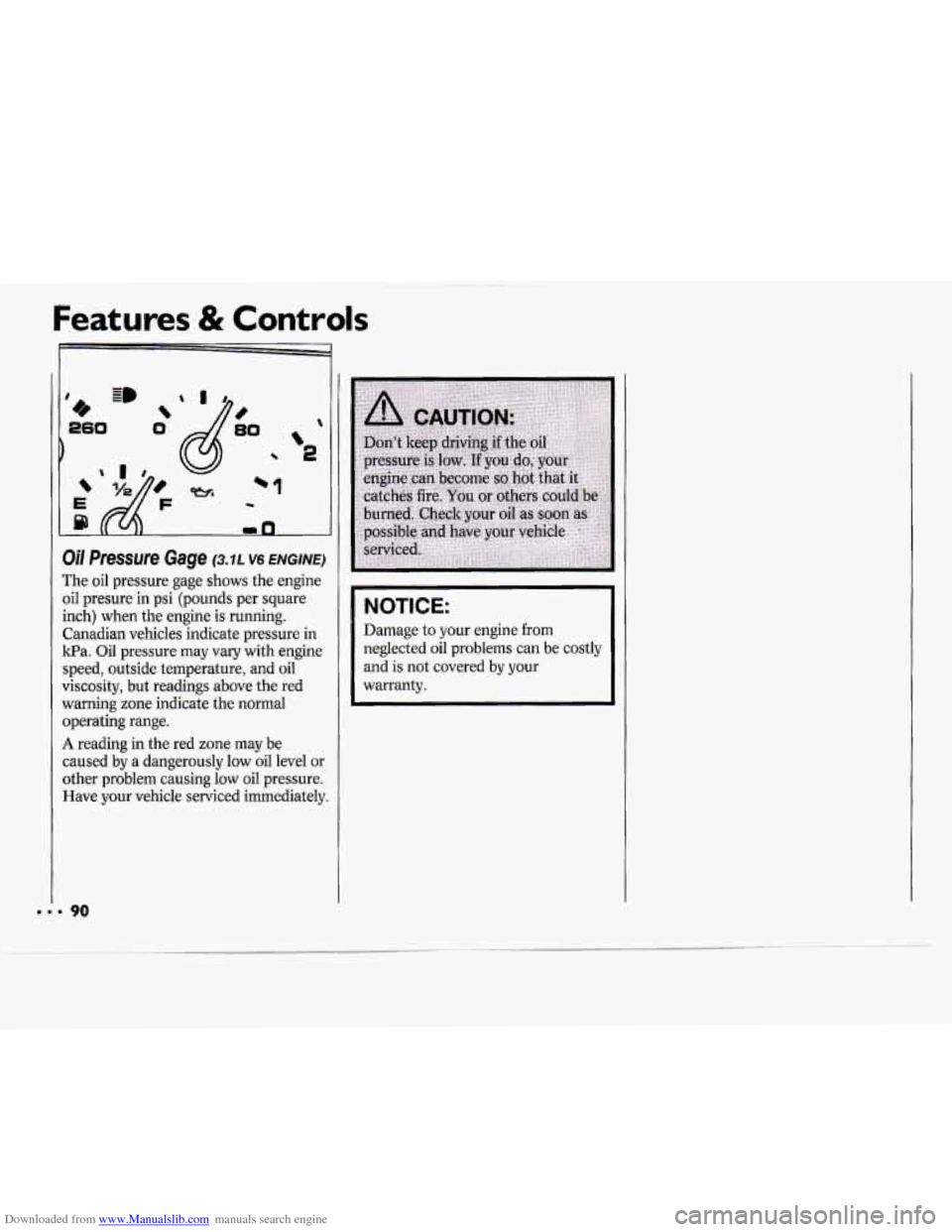
Downloaded from www.Manualslib.com manuals search engine Features & Controls
e
oil PfeSSUI'e Gage (3.7L V6 ENGINE)
The oil pressure gage shows the engine
oil presure in psi (pounds per square
inch) when the engine is running.
Canadian vehicles indicate pressure in
1tPa. Oil pressure may vary with engine
speed, outside temperature, and oil
viscosity, but readings above the red
warning zone indicate the
normal
operating range.
A reading in the red zone may be
caused by a dangerously low oil level or
other problem causing low oil pressure.
Have your vehicle serviced immediately.
NOTICE:
Damage to your engine from
neglected oil problems can be costly
and is not covered by your
warranty.
Page 122 of 243
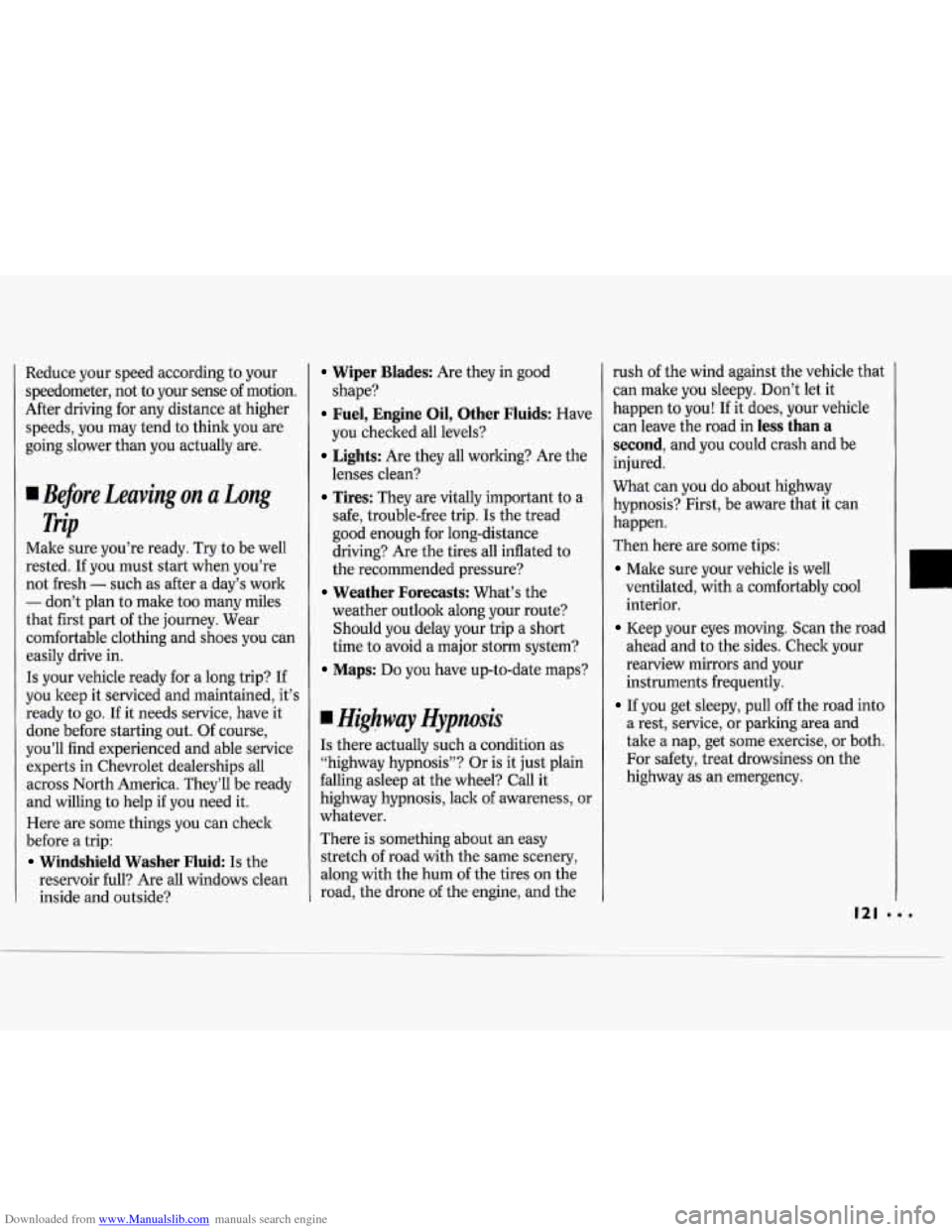
Downloaded from www.Manualslib.com manuals search engine Reduce your speed according to your
speedometer, not to your sense of motion.
After driving for any distance at higher
speeds, you may tend
to think you are
going slower than you actually are.
Before Leaving on a Long
Trip
Make sure you’re ready. Try to be well
rested.
If you must start when you’re
not fresh
- such as after a day’s work
- don’t plan to make too many miles
that first part
of the journey. Wear
comfortable clothing and shoes you can
easily drive in.
Is your vehicle ready for a long trip? If
you keep it serviced and maintained, it’s
ready to
go. If it needs service, have it
done before starting out. Of course,
you’ll find experienced and able service
experts in Chevrolet dealerships all
across North America. They’ll be ready
and willing to help
if you need it.
Here are some things you can check
before a trip:
Windshield Washer Fluid Is the
reservoir full? Are all windows clean
inside and outside?
Wiper Blades: Are they in good
shape?
Fuel, Engine Oil, Other Fluids: Have
you checked all levels?
Lights: Are they all working? Are the
lenses clean?
Tires: They are vitally important to a
safe, trouble-free trip.
Is the tread
good enough for long-distance
driving? Are the tires all inflated to
the recommended pressure?
weather outlook along your route?
Should you delay your trip a short
time to avoid a major storm system?
Maps: Do you have up-to-date maps?
Weather Forecasts: What’s the
Highway Hypnosis
Is there actually such a condition as
“highway hypnosis”? Or is it just plain
falling asleep at the wheel? Call it
highway hypnosis, lack
of awareness, or
whatever.
There is something about an easy
stretch of road with the same scenery,
along with the hum of the tires on the
road, the drone
of the engine, and the rush
of the wind against the vehicle that
can make you sleepy. Don’t let it
happen to you! If it does, your vehicle
can leave the road in
less than a
second,
and you could crash and be
injured.
What can you do about highway
hypnosis? First, be aware that it can
happen.
Then here are some tips:
Make sure your vehicle is well
ventilated, with a comfortably cool
interior.
Keep your eyes moving. Scan the road
ahead and to the. sides. Check your
rearview mirrors and your
instruments frequently.
If you get sleepy, pull off the road into
a rest, service, or parking area and
take a nap, get some exercise, or both.
For safety, treat drowsiness
on the
highway as an emergency.
a
Page 138 of 243
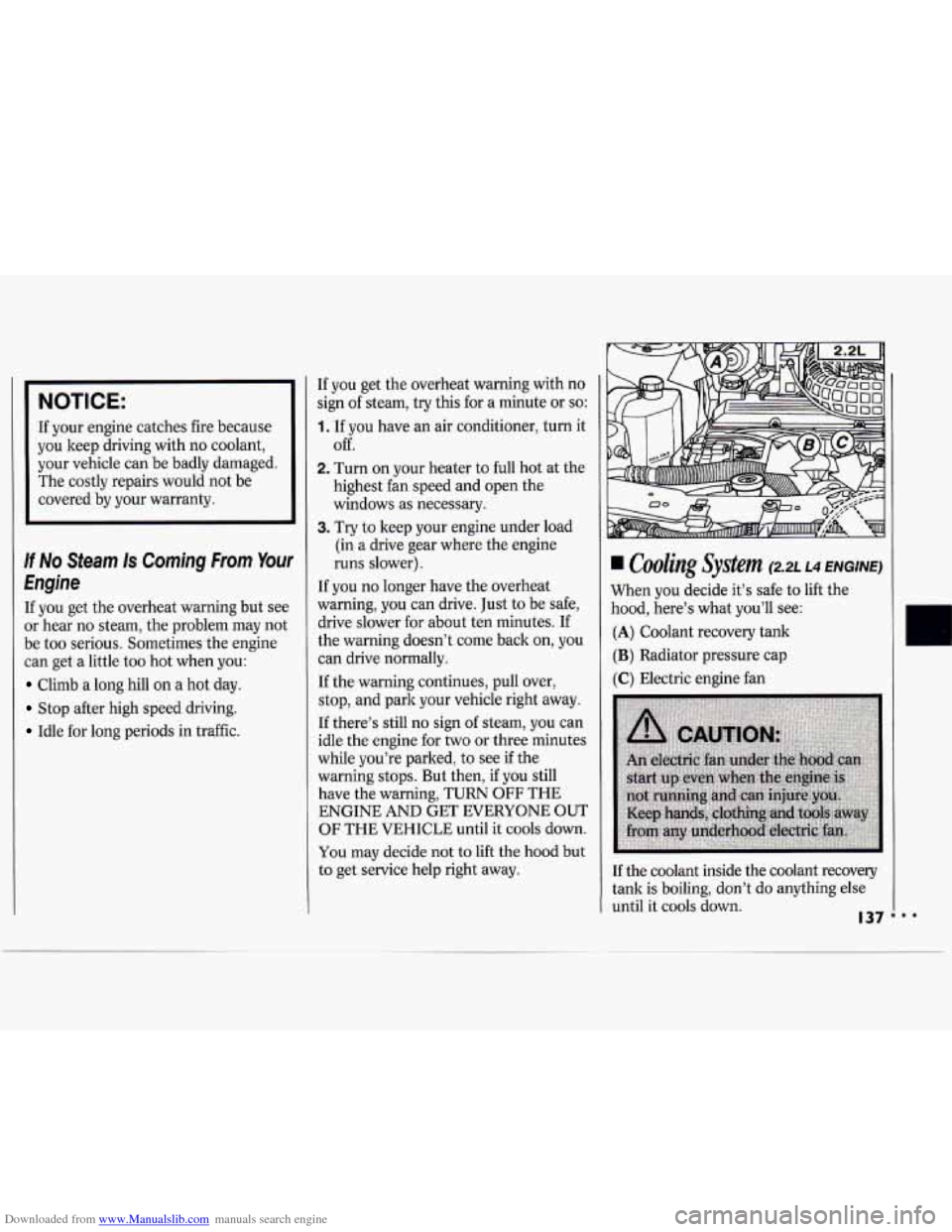
Downloaded from www.Manualslib.com manuals search engine I
NOTICE:
If your engine catches fire because
you keep driving with no coolant,
your vehicle can be badly damaged.
The costly repairs would not be
covered by your warranty.
If No Steam Is Coming From your
Engine
If you get the overheat warning but see
or hear no steam, the problem may not
be too serious. Sometimes the engine
can get a little too hot when you:
Climb a long hill on a hot day.
Stop after high speed driving.
Idle for long periods in traffic.
If you get the overheat warning with no
sign
of steam, try this for a minute or so:
1. If you have an air conditioner, turn it
2. Turn on your heater to full hot at the
Off.
highest fan speed and open the
windows as necessary.
3.
Try to keep your engine under load
(in
a drive gear where the engine
runs slower).
If you no longer have the overheat
warning, you can drive. Just
to be safe,
drive slower for about ten minutes.
If
the warning doesn’t come back on, you
can drive normally.
If the warning continues, pull over,
stop, and park your vehicle right away.
If there’s still no sign
of steam, you can
idle the engine for two or three minutes
while you’re parked, to see if the
warning stops. But then, if you still
have the warning, TURN
OFF THE
ENGINE AND
GET EVERYONE OUT
OF THE VEHICLE until it cools down.
You may decide not
to lift the hood but
to get service help right away.
hdirtg system (2.2L L4 ENGINE)
When you decide it’s safe to lift the
hood, here’s what you’ll see:
(A) Coolant recovery tank
(B) Radiator pressure cap
(C) Electric engine fan
If the coolant inside the coolant recovery
tank is boiling, don’t do anything else
until
it cools down. I37
Page 190 of 243
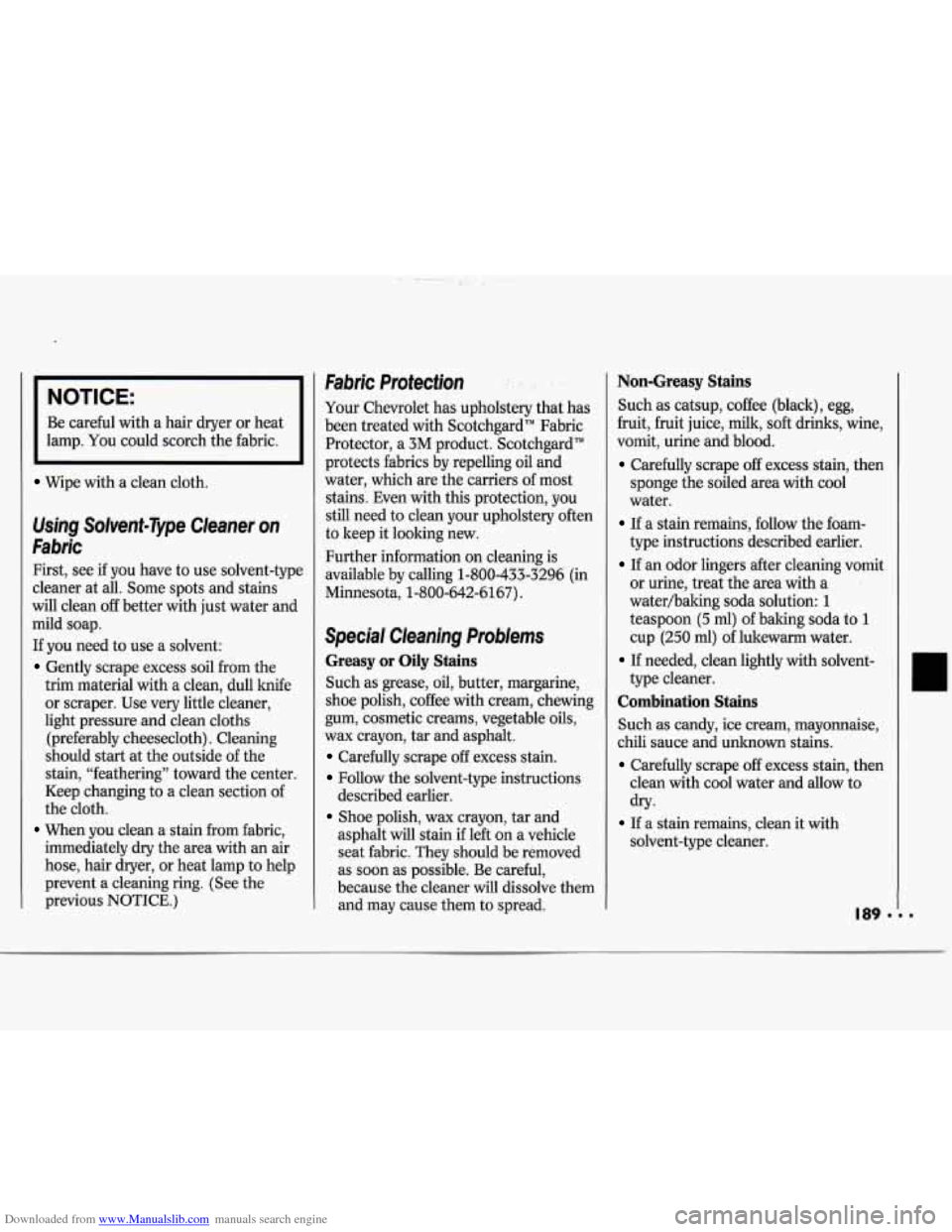
Downloaded from www.Manualslib.com manuals search engine NOTICE:
Be careful with a hair dryer or heat
lamp. You could scorch the fabric.
Wipe with a clean cloth.
Using Solvent-Type Cleaner on
Fabric
First, see if you have to use solvent-type
cleaner at all. Some spots and stains
will clean off better with just water and
mild soap.
If you need to use a solvent:
Gently scrape excess soil from the
trim material with a clean, dull knife
or scraper. Use very little cleaner,
light pressure and clean cloths
(preferably cheesecloth). Cleaning
should start at the outside of the
stain, “feathering” toward the center.
Keep changing to a clean section of
the cloth.
When you clean a stain from fabric,
immediately dry the area with an air
hose, hair dryer, or heat lamp to help
prevent a cleaning ring. (See the
previous NOTICE.)
Fabric hotection
Your Chevrolet has upholstery that has
been treated with Scotchgard’” Fabric
Protector, a 3M product. ScotchgardTM
protects fabrics by repelling oil and
water, which are the carriers of most
stains. Even with this protection, you
still need to clean your upholstery often
to keep it looking new.
Further information on cleaning is
available by calling 1-800-433-3296 (in
Minnesota, 1-800-642-6167).
Special Cleaning Problems
Greasy or Oily Stains
Such as grease, oil, butter, margarine,
shoe polish, coffee with cream, chewing
gum, cosmetic creams, vegetable oils,
wax crayon, tar and asphalt.
Carefully scrape off excess stain.
Follow the solvent-type instructions
Shoe polish, wax crayon, tar and
described earlier.
asphalt will stain if left on a vehicle
seat fabric. They should be removed
as soon as possible. Be careful,
because the cleaner will dissolve them
and may cause them to spread.
Non-Greasy Stains
Such as catsup, coffee (black), egg,
fruit,
fruit juice, milk, soft drinks, wine,
vomit, urine and blood.
Carefully scrape off excess stain, then
sponge the soiled area with cool
water.
If a stain remains, follow the foam-
type instructions described earlier.
If an odor lingers after cleaning vomit
or urine, treat the area with a
.
waterhaking soda solution: 1
teaspoon (5 ml) of baking soda to 1
cup (250 ml) of lukewarm water.
If needed, clean lightly with solvent-
type cleaner.
Combination Stains
Such as candy, ice cream, mayonnaise,
chili sauce and unknown stains.
Carefully scrape off excess stain, then
clean with cool water and allow to
dry-
If a stain remains, clean it with
solvent-type cleaner.
189 I
Page 192 of 243
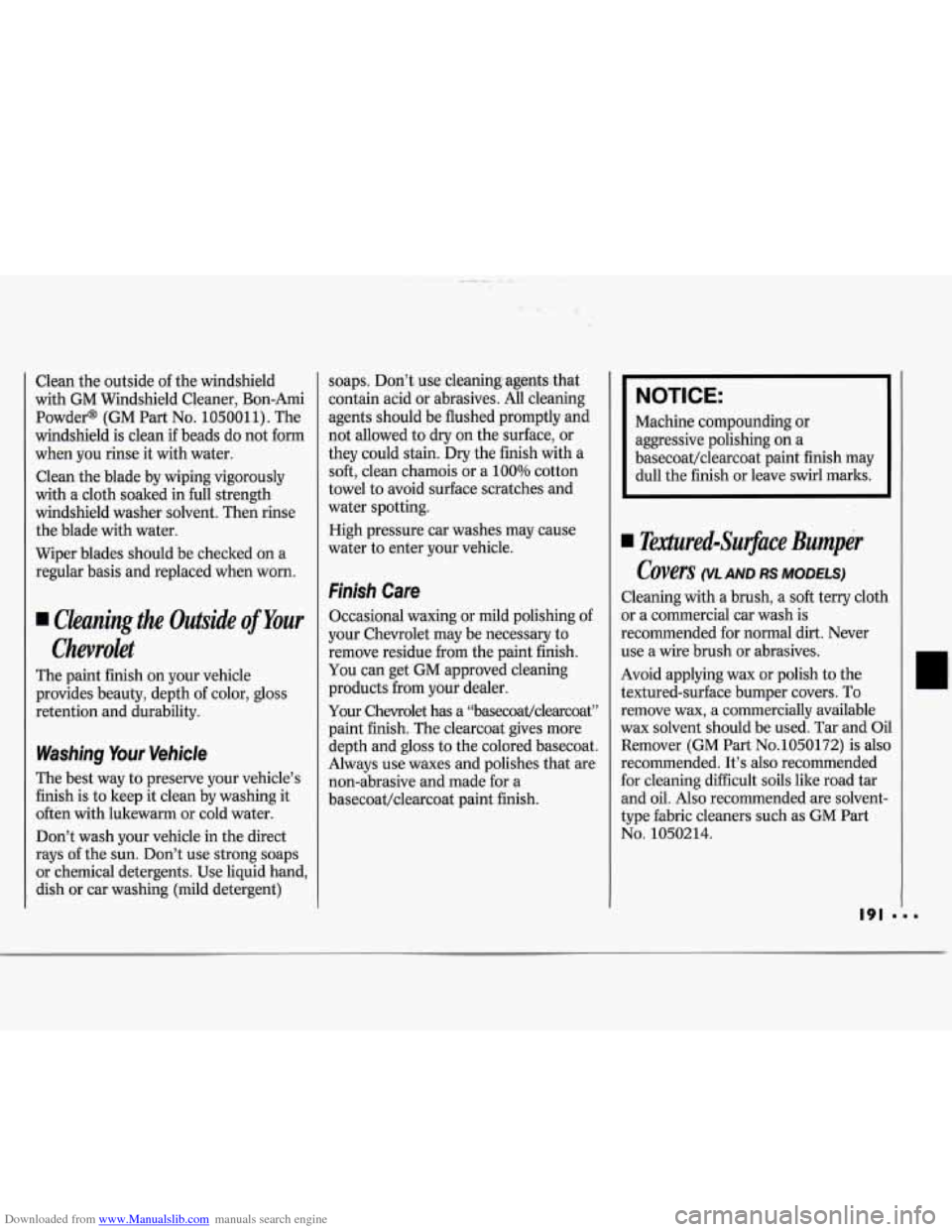
Downloaded from www.Manualslib.com manuals search engine Clean the outside of the windshield
with GM Windshield Cleaner, Bon-Ami
Powder@ (GM Part
No. 1050011). The
windshield is clean
if beads do not form
when you rinse it with water.
Clean the blade by wiping vigorously
with a cloth soaked in full strength
windshield washer solvent. Then rinse
the blade with water.
Wiper blades should be checked on a
regular basis and replaced when worn.
Cleuning tbe Outside of Your
Chevrolet
The paint finish on your vehicle
provides beauty, depth of color, gloss
retention and durability.
Washing Your Vehicle
The best way to preserve your vehicle’s
finish is to keep it clean by washing it
often with lukewarm or cold water.
Don’t wash your vehicle in the direct
rays
of the sun. Don’t use strong soaps
or chemical detergents. Use liquid hand,
dish or car washing (mild detergent) soaps. Don’t
usecleaning
8 @o&-that
contain acid
or abrasives. 31 cleaning
agents should be flushed promptly and
not allowed to dry on the surface, or
they could stain.
Dry the finish with a
soft, clean chamois or a 100% cotton
towel to avoid surface scratches and
water spotting.
High pressure car washes may cause
water to enter your vehicle.
Finish Care
Occasional waxing or mild polishing of
your Chevrolet may be necessary to
remove residue from the paint finish.
You can get GM approved cleaning
products from your dealer.
Your Chevrolet has a ‘Lbasecoat/clearcoat”
paint finish. The clearcoat gives more
depth and gloss to the colored basecoat.
Always use waxes and polishes that are
non-abrasive and made for a
basecoat/clearcoat paint finish.
NOTICE:
Machine compounding or
aggressive polishing on a
basecoat/clearcoat. paint finish may
dull the finish or leave swirl marks.
Rxtured-Surjace Bumper
Covers
WL AND RS MODELS)
Cleaning with a brush, a soft terry cloth
or a commercial car wash is
recommended for normal dirt. Never
use a wire brush or abrasives.
Avoid applying wax or polish to the
textured-surface bumper covers.
To
remove wax, a commercially available
wax solvent should be used. Tar and Oil
Remover (GM Part
No.1050172) is also
recommended. It’s also recommended
for cleaning difficult
soils like road tar
and oil.
Also recommended are solvent-
type fabric cleaners such as GM
Part
No. 1050214.
191 ...
Page 211 of 243
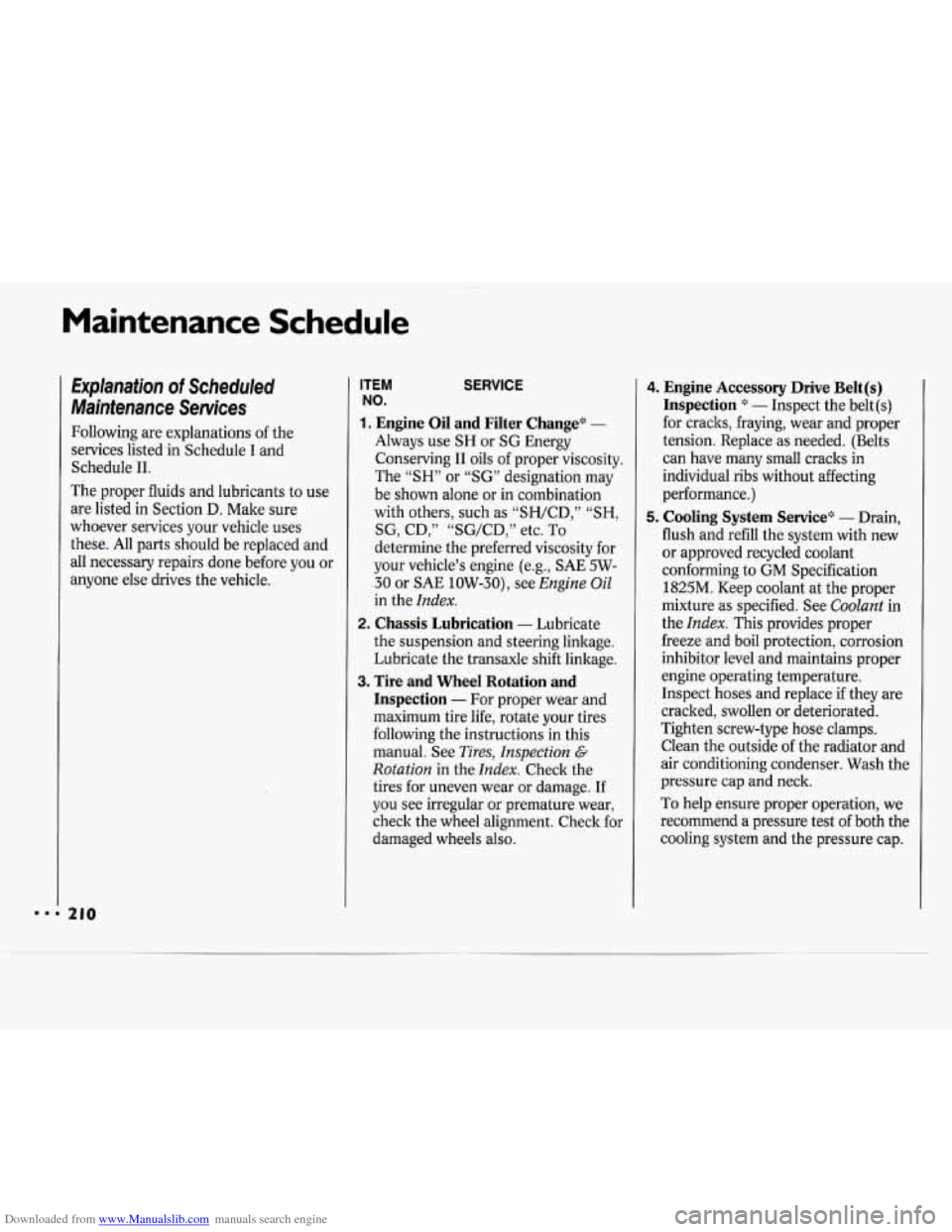
Downloaded from www.Manualslib.com manuals search engine Maintenance Schedule
Explanation of Scheduled
Maintenance Services
Following are explanations of the
services listed in Schedule
I and
Schedule 11.
The proper fluids and lubricants to use
are listed in Section
D. Make sure
whoever services your vehicle uses
these. All parts should be replaced and
all necessary repairs done before you or
anyone else drives the vehicle.
ITEM SERVICE
NO.
1. Engine Oil and Filter Change* -
Always use SH or SG Energy
Conserving I1 oils of proper viscosity.
The
“SH” or “SG” designation may
be shown alone or in combination
with others, such as “SH/CD,”
“SH,
SG, CD,” “SG/CD,” etc. To
determine the preferred viscosity for
your vehicle’s engine (e.g., SAE 5W-
30 or SAE 10W-30), see
Engine Oil
in the Index.
the suspension and steering linkage.
Lubricate the transaxle shift linkage.
Inspection - For proper wear and
maximum tire life, rotate your tires
following the instructions in this
manual. See
Tires, Inspection G
Rotation in the Index. Check the
tires for uneven wear or damage. If
you see irregular or premature wear,
check the wheel alignment. Check for
damaged wheels also.
2. Chassis Lubrication - Lubricate
3. Tire and Wheel Rotation and
4. Engine Accessory Drive Belt(s)
Inspection
* - Inspect the belt (s)
for cracks, fraying, wear and proper
tension. Replace as needed. (Belts
can have many small cracks in
individual ribs without affecting
performance.)
5. Cooling System Service* - Drain,
flush and refill the system with new
or approved recycled coolant
conforming to
GM Specification
1825M. Keep coolant at the proper
mixture as specified. See
Coolant in
the
Index. This provides proper
freeze and boil protection, corrosion
inhibitor level and maintains proper
engine operating temperature.
Inspect hoses and replace if they are
cracked, swollen or deteriorated.
Tighten screw-type hose clamps.
Clean the outside of the radiator and
air conditioning condenser. Wash the
pressure cap and neck.
To help ensure proper operation, we
recommend a pressure test
of both the
cooling system and the pressure cap.
Page 236 of 243
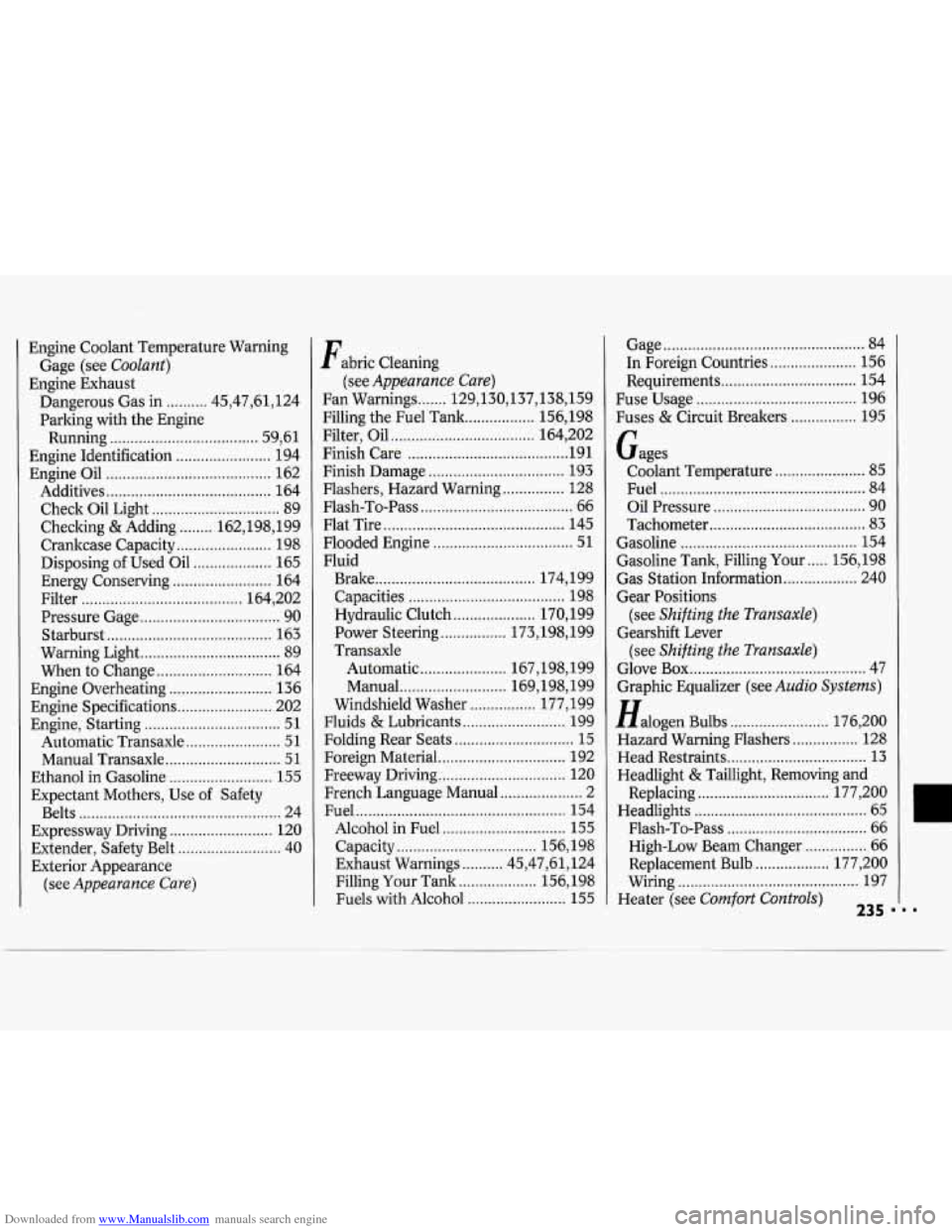
Downloaded from www.Manualslib.com manuals search engine Engine Coolant Temperature Warning
Engine Exhaust Gage (see
Coolant)
Dangerous Gas
in .......... 45.47.61. 124
Parking with the Engine
Running
.................................... 59. 61
Engine Identification
....................... 194
Engine Oil
........................................ 162
Additives
........................................ 164
Check Oil Light
............................... 89
Checking &Adding
........ 162.198. 199
Crankcase Capacity
....................... 198
Disposing of Used Oil
................... 165
Energy Conserving
........................ 164
Filter
....................................... 164. 202
Pressure Gage
.................................. 90
Starburst
........................................ 163
Warning Light
.................................. 89
When to Change
............................ 164
Engine Overheating
......................... 136
Engine Specifications ....................... 202
Engine. Starting
................................. 51
Automatic Transaxle
....................... 51
Manual Transaxle
............................ 51
Ethanol in Gasoline
......................... 155
Expectant Mothers. Use
of Safety
Belts
................................................. 24
Extender. Safety Belt
......................... 40
Exterior Appearance
Expressway Driving
......................... 120
(see Appearance
Care)
Fabric Cleaning
Fan Warnings
....... 129.130.137.138. 159
Filling the Fuel Tank
................. 156. 198
Filter. Oil
................................... 164, 202
Finish Care
....................................... 19 1
Finish Damage ................................. 193
Flashers, Hazard Warning
............... 128
Flash-To-Pass
..................................... 66
Flat Tire
............................................ 145
Flooded Engine
.................................. 51
Fluid Brake
....................................... 174, 199
Capacities
...................................... 198
Hydraulic Clutch
.................... 170. 199
Power Steering
................ 173,198, 199
Transaxle Automatic
..................... 167,198, 199
Manual
.......................... 169,198, 199
Windshield Washer
................ 177, 199
Fluids
& Lubricants ......................... 199
Foreign Material
............................... 192
Freeway Driving
............................... 120
French Language Manual
.................... 2
Fuel
................................................... 154
Alcohol in Fuel
.............................. 155
Capacity
.................................. 156, 198
Exhaust Warnings
.......... 45,47,61, 124
Filling Your Tank
................... 156, 198
Fuels with Alcohol
........................ 155
(see
Appearance
Care)
Folding Rear Seats ............................. 15
Gage ................................................. 84
In Foreign Countries ..................... 156
Requirements
................................. 154
Fuse Usage
....................................... 196
Fuses
& Circuit Breakers ................ 195
Gages Coolant Temperature
...................... 85
Fuel .................................................. 84
Oil Pressure
..................................... 90
Tachometer
...................................... 83
Gasoline ........................................... 154
Gasoline Tank, Filling Your
..... 156, 198
Gas Station Information
.................. 240
Gear Positions
Gearshift Lever
Glove Box
........................................... 47
Graphic Equalizer (see
Audio Systems)
Halogen Bulbs ........................ 176, 200
Head Restraints
.................................. 13
Headlight & Taillight, Removing and
(see
Shifting
the Transaxle)
(see Shifting the Transaxle)
Hazard Warning Flashers ................ 128
Replacing
................................ 177, 200
Headlights
.......................................... 65
Flash-To-Pass
.................................. 66
High-Low Beam Changer
............... 66
Replacement Bulb
.................. 177, 200
Wiring
............................................ 197
Heater (see
Comfort Controls) 235 1 . .
Page 237 of 243
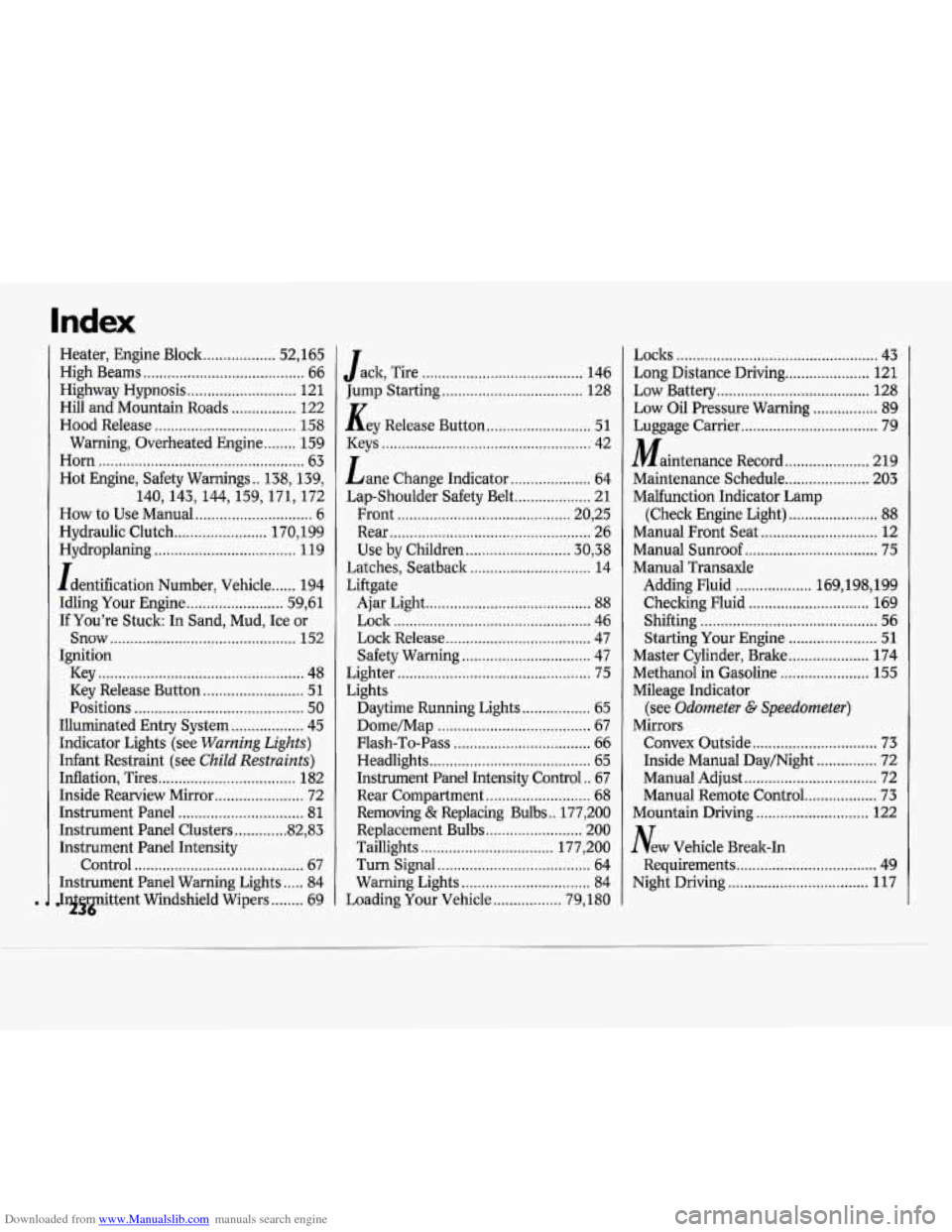
Downloaded from www.Manualslib.com manuals search engine Heater. Engine Block .................. 52. 165
High Beams ........................................ 66
Highway Hypnosis
........................... 121
Hill and Mountain Roads
................ 122
Hood Release
................................... 158
Warning. Overheated Engine
........ 159
Horn
................................................... 63
Hot Engine. Safety Warnings
.. 138. 139.
140.143.144.159.171. 172
How to Use Manual ............................. 6
Hydraulic Clutch
....................... 170. 199
Hydroplaning
................................... 1 19
Identification Number. Vehicle
...... 194
If You're Stuck: In Sand. Mud. Ice or
Ignition Idling Your Engine
........................ 59. 61
Snow .............................................. 152
Key
................................................... 48
Key Release Button
......................... 51
Positions
.......................................... 50
Illuminated Entry System
.................. 45
Indicator Lights (see
Warning Lights)
Infant Restraint (see Child Restraints)
Inflation. Tires .................................. 182
Inside Rearview Mirror
...................... 72
Instrument Panel
............................... 81
Instrument Panel Clusters ............. 82. 83
Instrument Panel Intensity
Control
.......................................... 67
Instrument Panel Warning Lights 84
ittent Windshield Wipers 69
.....
.'95iP ........
Jack. Tire ........................................ 146
Key Release Button .......................... 51
Jump Starting
................................... 128
Keys
.................................................... 42
Lap-Shoulder Safety Belt
................... 21
Use by Children
.......................... 30'38
Latches, Seatback
.............................. 14
Liftgate
Lane
Change Indicator
.................... 64
Front
........................................... 20, 25
Rear .................................................. 26
Ajar Light
......................................... 88
Lock ................................................. 46
Lock Release
.................................... 47
Safety Warning
................................ 47
Lighter
................................................ 75
Lights Daytime Running Lights
................. 65
Dome/Map ...................................... 67
Flash-To-Pass
.................................. 66
Headlights
........................................ 65
Instrument Panel Intensity Control
.. 67
Rear Compartment
.......................... 68
Removing & Replacing Bulbs .. 177, 200
Replacement Bulbs
........................ 200
Taillights
................................. 177, 200
Turn Signal
...................................... 64
Warning Lights
................................ 84
Loading Your Vehicle
................. 79, 180 Locks
.................................................. 43
Long Distance Driving
..................... 121
Low Battery
...................................... 128
Low Oil Pressure Warning
................ 89
Maintenance Record ..................... 219
Maintenance Schedule
..................... 203
Malfunction Indicator Lamp
(Check Engine Light)
...................... 88
Manual Front Seat ............................. 12
Manual Sunroof
................................. 75
Manual Transaxle
Luggage
Carrier
.................................. 79
Adding Fluid
................... 169,198, 199
Checking Fluid
.............................. 169
Shifting
............................................ 56
Starting Your Engine
...................... 51
Master Cylinder. Brake
.................... 174
Methanol in Gasoline
...................... 155
Mileage Indicator
Mirrors (see
Odometer G Speedometer)
Convex
Outside ............................... 73
Inside Manual Day/Night
............... 72
Manual Adjust
................................. 72
Manual Remote Control
.................. 73
Mountain Driving
............................ 122
New Vehicle Break-In
Requirements
................................... 49
Night Driving ................................... 117